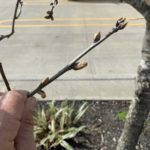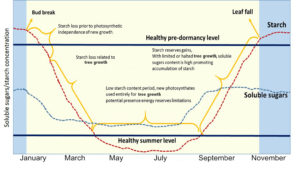
Figure 1. These oak tree buds may look dormant but have completed their chilling requirement and are ready to break.
We all have heard about dormancy and the restful time of woody plants in our landscapes. That “chill-out” time is nearing the end and it’s time to think about tree maintenance. Trees and shrubs have actually been growing for quite some time, we just can’t see it… yet. Woody plants begin growth after the chilling requirements have been filled. These requirements are different for every plant. Chilling units are hours of time spent above freezing. The number of hours required for chilling varies for different plants from less than 500 to 1,500 hours or more. Many people think the plant is tracking hours below freezing, but in actuality, hours below freezing has no effect on chilling but does increase cold hardiness. Our mild winter and early spring arrival is playing a role in this process.
An important maintenance task is supplemental fertilization during early spring weather, especially if there wasn’t any type of fall fertilization. Let’s take a look at how a tree uses and gains energy during the year to understand why and when trees need good nutrition. After the leaves have fallen there is no way to generate food because without leaves, there is no photosynthesis. There are huge demands on the carbohydrate reserves due to increased metabolic functions to support new leaves, flowers and fruit. Supplemental nutrition can help if storage levels are low or depleted until the new photosynthates are available. That’s a huge demand on its reserves! The tree must rely on stored carbohydrate reserves in its woody parts such as stems and branches to grow. Hopefully, the tree was healthy and developing those reserves going into fall or supplemental nutrition was offered with fall fertilization. If not, then the tree exhausts much of its energy and is in need of new resources. In some situations, it may be considered safer for the tree to apply fertilizer in the spring. Fall applications, if applied too early in the fall season, can create the risk of forcing the plant into becoming metabolically active right when cold weather hits, creating growth susceptible to freeze damage.

Figure 2. The graph shows the starch loss or energy used during various growing stages for the tree during the year. Most energy is depleted after leaf emergence and then regained as leaves begin photosynthesizing new resources.
Many woody plants begin the new year’s growth with stored food from the year before. An application of fertilizer in the spring gives an additional boost to this new growth. It is important to note that not all trees and shrubs need fertilization, however, most can benefit from this application, especially the younger actively growing trees. In forests, soils have an abundance of nutrients, but in our landscapes and urban forest areas, that’s not often the case. As we sweep away leaves, twigs and fallen bark, we’re removing potential recycling of nutrients for the soil. Additionally, the grass around our trees is unnatural and often outcompetes trees for available nutrients and water. That’s why we need to fertilize our trees, spring or fall. Look for signs that your tree is lacking nutrients in the soil. If you see these signs, fertilization may be necessary.
- Shorter than normal annual twig growth
- Undersized leaves that are fewer in number
- Dead branches and branch tips
- Leaf veins darker than leaf margins
- Leaves any other color than dark green, such as yellow or red
However, never fertilize without getting a soil test. If your trees are experiencing any of the above symptoms, have your local arborist inspect the tree to determine the best treatment. Also, Review https://www.extension.purdue.edu/extmedia/HO/HO-140-W.pdf for more details on fertilizer application techniques and rates.
Now for just a little about tree pruning. All of that new tree growth is going to prompt the pruning activities… be patient! Once trees start budding and blooming in the spring hold off until after the flush. Pruning in the spring can limit bloom potential and remove newly expanding leaves that will be needed to produce new food products for energy.
Generally, the best time to prune is several weeks after the spring flush or during the summer months. Early spring pruning should focus primarily on pruning for safety to remove any dead, dying or decayed branches. Aesthetic or structural pruning can be completed much later and when the tree is better prepared to seal those pruning wounds with energy reserves. For more information refer to the publication Tree Pruning Essentials from the Education Store on pruning topics.